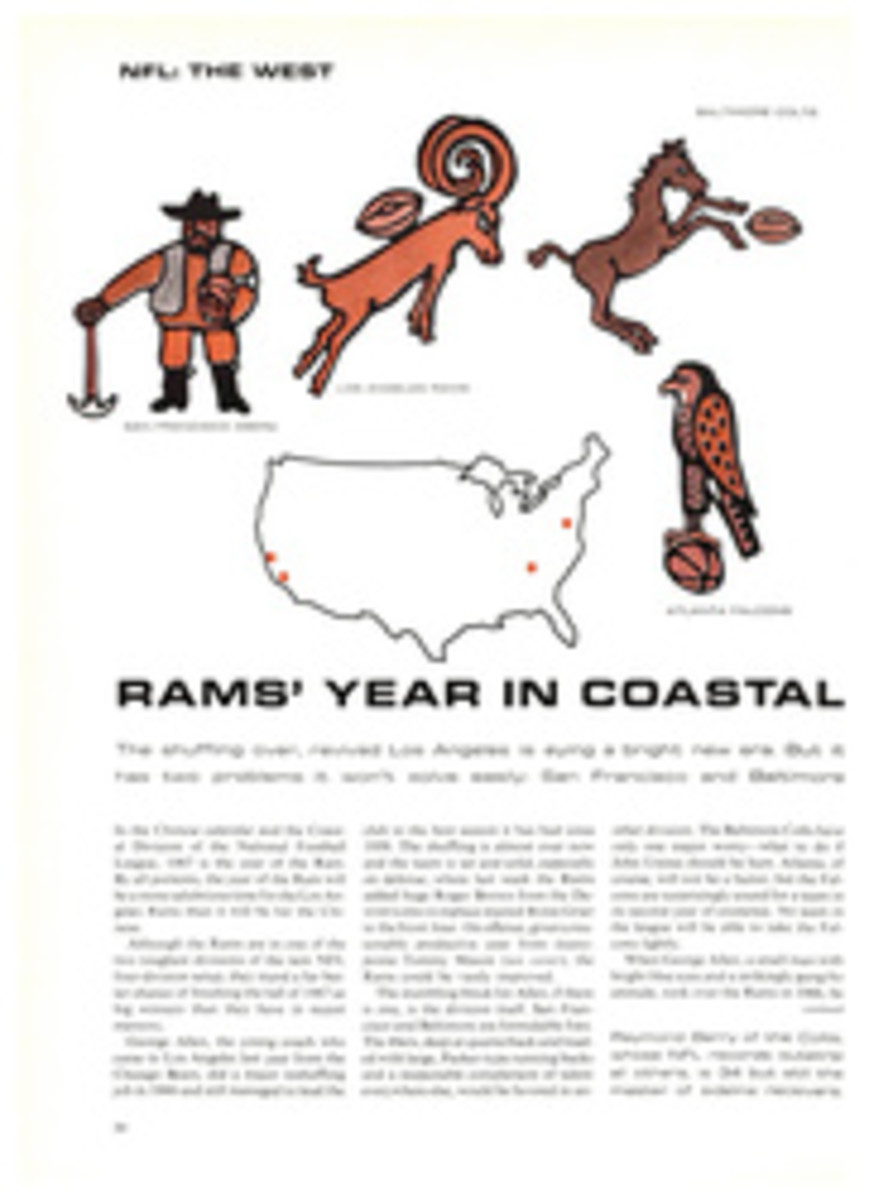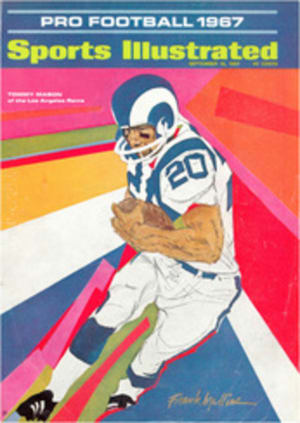
Two who didn't stay away
Some of the best tennis players in the world were not at Forest Hills last week for the U.S. National Singles Championships. Fred Stolle, last year's winner, was in South Africa, playing as a pro. With him was Dennis Ralston. Manuel Santana, the 1965 champion, remained in Europe with "other commitments." Lieutenant Arthur Ashe could not get a leave from his post at West Point, a few miles away. Australia's Tony Roche made it to Forest Hills and was third-seeded until he awoke one morning just before the tournament began and found he could not raise his left arm above his shoulder—the result of a golf injury, of all things. Even the women's division was affected. Both Maria Bueno, the defending champion, and Nancy Richey, the second-ranked U.S. player, were out with ailments.
Unfortunately for those who did show up at Forest Hills, there was nothing wrong with John Newcombe or Billie Jean King. The two Wimbledon champions were never in any real danger of losing a match, and, in fact, if all the absentees had been able to play at Forest Hills, it is probable that both would have won anyway.
Mrs. King proved that she now deserves to be ranked near the top of the great woman players in history. At Forest Hills, as at Wimbledon, she did not lose a single set, beating South Africa's Annette Van Zyl in the quarterfinals, France's Françoise Durr in the semis and England's Ann Haydon Jones in the finals. Rosemary Casals, who might have given Billie Jean, her friend and doubles partner, difficulty (she has beaten her three times in two years) was put out by 18-year-old Peaches Bartkowicz, who in turn was beaten by Mrs. Jones.
Newcombe had a little more trouble making his way to the title—but not much. At the start of the tournament it seemed as if he, too, might be among the missing. Playing an exhibition a few days earlier, he had strained a back muscle and had been forced to default. In reaching the semifinal round at Forest Hills he lost a set to Mike Estep in the first round, Cliff Richey in the third, Ray Moore of South Africa in the fourth and Bob Hewitt, an Australian now living in South Africa, in the quarters. In fact, Hewitt, a player known for his delightfully wicked temper, came within a few strokes of taking a second set from Newcombe.
It was the semifinals of the tournament that clearly showed what kind of Forest Hills it was. There was Newcombe, of course, just as he should be. But his opponent was a 29-year-old lawyer (address: 1 Wall Street) and weekend player named Gene Scott who had long since given up any dreams he might have had of becoming a true tennis hero. At his best, which was four years ago, Scott was the fourth-ranked player in the country and a member of the Davis Cup team, but he had never progressed past the fourth round at either Wimbledon or Forest Hills. Like his friends Chuck McKinley and Frank Froehling, who also work at 9-to-5 jobs and now play only friendly tennis, Scott entered the Nationals for the fun of it. If he got a good draw, he might beat a couple of people before losing. If he got a bad draw—out.
And it was a bad draw. Tony Roche was his first-round opponent, and by Scott's own admission, there was no way he could win unless something crazy happened, such as Roche waking up and not being able to raise his arm.
Once past Roche, Scott polished off three lesser players before meeting another U.S. player, Ron Holmberg. Scott beat him in five sets—an upset of sorts—when Holmberg blew an overhead at match point. That put Scott in the quarterfinals against Australia's Owen Davidson, a rugged left-hander who is a regular on the tour. "I've already put out one Australian left-hander," Scott said airily as he sized up his chances, which in truth were near zero. Anyone who knew anything about tennis could tell you that.
So of course Scott went out and beat Davidson in straight sets. Just like that he had qualified to be on national TV against the amateur champion of the world, John Newcombe.
In the other half of the semifinals was a 26-year-old pharmacist from Copenhagen, Jan Leschly, who was seventh-seeded at Wimbledon ("Heaven knows why," he said) but who was almost totally unknown in this country. A lefthander, Leschly combined a deadly forehand with a marvelous sense of humor, knocking out Cliff Drysdale, Thomas Koch and Ronnie Barnes in succession and keeping the galleries laughing as he did it.
Leschly's opponent in the semis was Clark Graebner, who rarely if ever finds anything to laugh about on a tennis court. A year ago Graebner was suspended from the Davis Cup team for bad court manners. Since then his behavior has been commendable, but he still acts as if death would be his punishment for losing, a behavior trait characteristic of many U.S. players.
Like Scott and Leschly, Graebner had never before reached the semifinals at Forest Hills, and at 23, married and with a young daughter, he had arrived at the stage where he, too, was considering giving up year-round tennis for a job. Graebner had no problems in the early stages of the tournament, but in the quarterfinals he met Roy Emerson, now 31 and only the shadow of the player he once was. Still, the shadow was enough to push Graebner to four sets, including a titanic 19-17 third set, before Graebner won. Thus the reformed bad boy joined the pharmacist and the lawyer in the semifinals with John Newcombe.
On Saturday in the Forest Hills stadium, Gene Scott's adventure came to an abrupt ending. Newcombe ran through him in three straight sets. For a while it looked as if the Graebner-Leschly match would last only three sets, too. Playing like a man too happy to be nervous ("I woke up this morning and couldn't believe I was in the semifinals"), Leschly won the first two sets, never losing more than one point on his serve. Graebner, on the other hand, looked stiff and double-faulted frequently, whereas the day before his serves had made Emerson shake his head.
Graebner continued to double-fault in the third set, but he held on and finally broke Leschly's serve to win it. As he entered a dressing room beneath the stadium for the 10-minute break, he was followed almost immediately by Bill Talbert and Gardnar Mulloy and by his wife Carole, who throughout the tournament (when she was not playing herself) signaled encouragement from the stands.
"You're not throwing the ball high enough on your serve," said Talbert.
"You're not throwing the ball high enough," repeated Mulloy.
"Honey, please throw it higher," pleaded Carole.
After the intermission Graebner took over. He won the fourth set quickly, and gained an early service break in the fifth. Leschly made a gallant effort, breaking Graebner's serve to even it at 5-5, but he immediately lost his own and, minutes later, the match. At the final point Graebner flipped his racket in the air and leaped the net to console his opponent, but Leschly, a comedian to the end, also leaped the net, passing the startled Graebner in mid-air. Landing, Leschly gave a hilarious "where did he go?" pantomime, then stepped back over the net to congratulate the American.
It was no clown that Graebner faced the following day. Newcombe was merciless and swift, beating the American in three sets. Thus for the 12th year in a row the U.S. was unable to win its own National men's singles title (the Australians have won it nine times in that period). Unless someone can convince John Newcombe to join the crowd who stayed away from Forest Hills this year, the drought may last indefinitely.
PHOTO
SURROUNDED BY NEWSMEN, WIMBLEDON AND U.S. CHAMP BILLIE JEAN HOLDS COURT
PHOTO
BROUGHT BRIEFLY TO HIS KNEES, GRAEBNER ROSE TO WIN SEMIS, THEN FELL AGAIN

